#Lew Kan
Photo
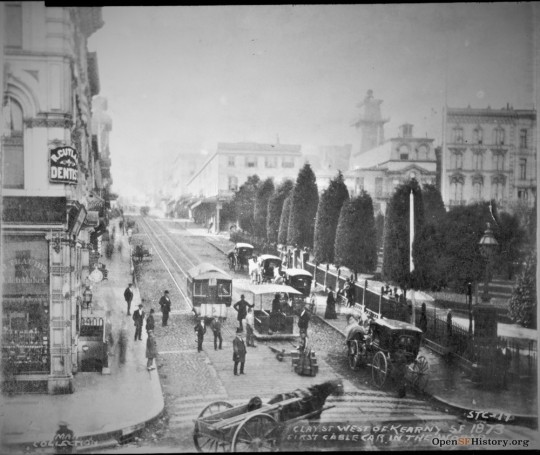
"Clay St. West of Kearny SF 1873 - First Cable Car in the World"
In this elevated view west on Clay Street to the Clay St. Cable RR cable car at Kearny Street Terminus, Portsmouth Square can be seen on the right. Signage for the R. Cutlar Dentist, H. Traube watchmaker and jeweler at left. This photo is a detail from Carleton Watkins' stereo card number 2368 (Variant) under the original title: "Clay St. Hill R.R., San Francisco, Cal. Run by A.S. Hallidie's patent Endless Steel Wire Rope and Gripping Attachment. Overcomes an Elevation of 307 feet in a length of 2800 feet. Worst grade, one foot in six" (from the Marilyn Blaisdell Collection). The photo is also notable as one of the very few photographs showing a pre-1906 Chinese resident in the same frame as a cable car.
Chinatown at the Advent of the Cable Car
This year San Francisco marks the sesquicentennial of its cable car system. In the late 19th century, San Francisco experienced rapid urbanization and faced the challenge of its hilly terrain. Traditional horse-drawn streetcars struggled to navigate the steep inclines, necessitating an innovative transportation solution.
In the predawn hours of August 2, 1873, Andrew Smith Hallidie introduced the first successful cable car system in the world. The cable cars utilized an underground cable mechanism to propel the cars along tracks, overcoming the city's hilly landscape. This new mode of transportation revolutionized urban mobility and played a pivotal role in San Francisco's development.

California and Montgomery streets, c. 1889. Photographer unknown (from the Martin Behrman Negative Collection / Courtesy of the Golden Gate NRA, Park Archives). The view is west on California across Montgomery, as an Omnibus Railway Co. horsecar #11 passes the Parrott Building, or Parrott Block (1852, Architect Stephen Williams) seen in background. A Chinese man is walking south at the northeast corner of the intersection. The signs for the offices of Equitable Life and Dr. William F. McNutt at 405 Montgomery are visible at right.
The introduction of cable cars in San Francisco had a profound impact on the Chinese community. Several cable car lines conveniently passed through Chinatown, allowing Chinese residents to access transportation. The cable cars provided a reliable means of travel for the community, connecting them to other neighborhoods and employment opportunities initially for domestic workers serving the mansions atop Nob Hill and eventually throughout the city.

Clay Street Cable Car, c. 1873. Photograph by Carleton Watkins and published as “Pacific Coast. 2369″ and by Taber Photo (from the Marilyn Blaisdell collection). In this startling image, patrons and car operators can be seen posing on or alongside cable cars on Clay near Jones Street, except for at least two Chinese men seated in the car at left. Their faces were lost to history because one man placed his hat over his face, while the other inclined his head to avoid the camera’s lens. Watkins' image may be the only extant image showing urban pioneer Chinese actually riding an early cable car, possibly to their jobs as domestic servants for the mansions on Nob Hill.
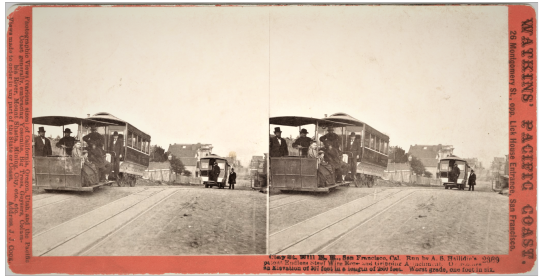
Watkins' stereo card bears the legend: “Clay Street Hill R.R., San Francisco, Cal. Run by A.S. Hallidie's patent Endless Steel Wire Rope and Gripping Attachment. Overcomes an Elevation of 307 feet in a length of 2800 feet. Worst grade, one foot in six. 2369” Photograph by Carleton E. Watkins (from the collection of the San Francisco Public Library).

“At the Corner of Dupont and Jackson Streets” c. 1896 -1906. Photograph by Arnold Genthe (from the Genthe photograph collection, Library of Congress, Prints and Photographs Division). A cable car on the Jackson Street line can be seen at right. “Two girls wearing embroidered holiday wear are crossing the street,” as historian Jack Tchen wrote in his book about Genthe’s Chinatown photos. “The store behind them is a ‘Chinese and Japanese Curios’ store located at 924 Dupont Street, southwest corner. The good-quality, expensive vases in the window display and the sign in English indicate that the store catered especially to tourists. Some such stores were owned by Japanese, but the main reason that both Chinese and Japanese goods were sold in the same store was that the general public could not distinguish between the two cultures.” (NOTE: Tchen’s location of the address at 924 Dupont appears incorrect, as the photo depicts the west or odd-numbered side of the street. The building bearing an address of 943 Dupont actually occupied the southwest corner of the intersection with Jackson Street. Directories of the time indicate that the Tong Yuen Lai confectionary operated at the 943 address during the 1890’s. By the 1905 publication of the Chinatown phone directory, the Jong Mee Cigar Store had either co-located or operated solely at the address.)
The cable cars, particularly the Clay, Sacramento, California, and Jackson street lines, had played a significant role in fostering economic growth within Chinatown.

“B 3096 Clay Street Hill, Chinatown, San Francisco” c. 1885. Photograph by Isaiah West Taber (from the Marilyn Blaisdell Collection). In this view east on the south side of Clay Street, and just above Dupont, the trees of Portsmouth Square can in the distance at left, a horsecar can be seen on Kearny and an original Clay Street cable car. The large billboard for Globe Business College and Conservatory of Music in distance. The large vertical sign in Chinese denotes an herbalist or apothecary store.

The view east on Clay Street, c. 1888. (Photographer unknown from the collection of the California Historical Society). A cable car is in the process of crossing Dupont Street and heading west up the hill. The balconies of the Yoot Hong Low restaurant appear at left.

“161 Street Scene in Chinatown,” no date. Photographer unknown (from a private French collection). A cable car can be seen traveling west on Clay passing Stockton Street.

“Chinese Quarter, San Francisco, Cal.” c. 1891. Photograph by A.J. McDonald (from a private collection). A cable car is seen passing the 800-block of Clay Street between Dupont St. and Waverly Place. The decorated balconies of the Yoot Hong Low restaurant can be seen at center.

“B 2807 Lotta’s Fountain, and junction of Market, Kearny a& Geary Streets, S.F.” c. late 1880s. Photograph by Isaiah West Taber (from a private collection). A Market Street Cable Rail car appears in the right foreground. Two Chinese men can be seen in the background at left on the sidewalk between the two lampposts and under the Philadelphia Lager sign.

“Carrying New Year Presents” c. 1900-1905. Photograph by Arnold Genthe (from the Genthe photograph collection, The Library of Congress, Prints and Photographs Division). A cable car can be seen on the hill just behind the head of the young woman in the photo. She appears to have been a servant to the family of prominent merchant Lew Kan. The boy in the photo is Lew Bing Yuen, the older son, who also appears in Genthe’s well-known photo “Children of the High Class.”
After transformation of post-1906 Chinatown into the “Oriental City,” this urban transit network remained crucial the neighborhood’s integration with the citywide economy. Tourists and locals utilized the cable car system, and Chinese-owned businesses along, and in proximity to, the cable car lines experienced increased patronage. This urban mobility represented by the cable car system, even after its reduction to only two lines, has sustained the Chinese community from it pioneer beginnings to this day.
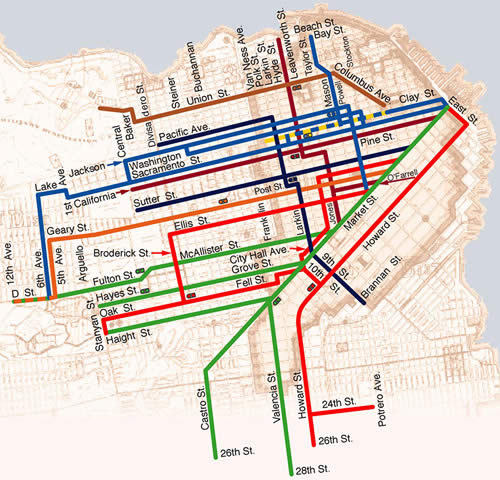
“San Francisco Cable Car Lines at the Fullest Extent of Operation (1890s)” (courtesy of the Cable Car Museum). As the Cable Car Museum advises here, “Clay Street Hill Railroad was the sole cable car company for 4 years. A former horsecar company, Sutter Street Railroad, developed its own version of Hallidie's patented system and began cable service in 1877, followed by California Street Cable Railroad -1878, Geary Street, Park & Ocean Railroad -1880, Presidio & Ferries Railroad -1882, Market Street Cable Railway -1883, Ferries & Cliff House Railway -1888, and Omnibus Railroad & Cable Company -1889.” At its peak, the San Francisco companies had laid “53 miles of track stretching from the Ferry Building to the Presidio, to Golden Gate Park, to the Castro, to the Mission.”
For the Chinese families who began to populate the eastern slopes of Nob and Russian Hills (and the garment workers in the small sewing factories along Pacific Avenue west of Stockton Street), the cable cars served as their principal transit system until the establishment of bus routes such as the Pacific Avenue shuttle (championed by Phil Chin and his Chinatown Transportation Improvement Project crew a half-century ago), and now known as the no. 12 Folsom/Pacific line.

A group of women (at least one of whom has bound feet) disembarks from a cable car in 1908. Photographer unknown (from the collection of the Chinese Historical Society of America). For women with bound feet (including great grandmothers on both sides of my family), the cars represented not only convenience but a necessary travel option for the residents navigating the hilly topography of San Francisco Chinatown.
The clang of cable car bells and the snap of the cable in the tracks remain an integral part of the soundtrack for the several generations of Chinese children who grew up in the greater Chinatown area.
Cable cars symbolized the vital role of urban transportation in fostering connections and opportunities -- providing convenient travel options for the residents of Chinatown, maintaining the neighborhood’s economy during hard times, and tying the segregated Chinese community to the larger city.
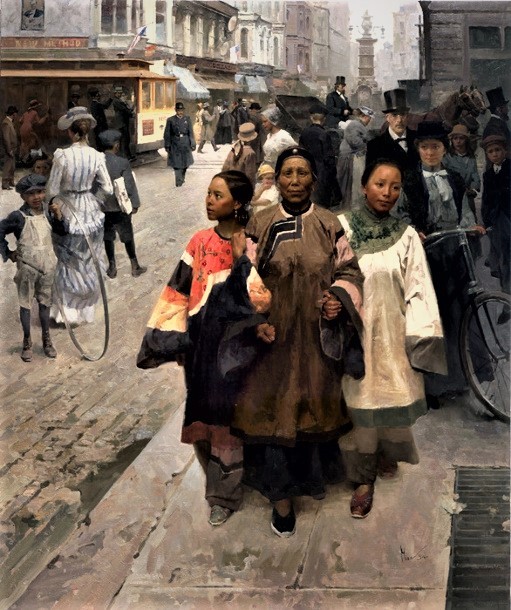
“Convergence of Cultures” oil painting by Mian Situ.
[updated 2023-8-14]
#Chinatown and the cable cars#Chinese riding 1873 cable car#Carleton Watkins#Andrew Hallidie#Clay Street cable car line#Chinatown Transportation Improvement Project#Lew Kan#Lew Bing Yuen#Sacramento Street cable car line#Jackson Street cable car line#Market Street Cable Rail line
4 notes
·
View notes
Text
SoDÅ / WoT: “Strangers and Friends” [S02E02].
Serie: Sagan om Drakens Återkomst.
Originaltitel: The Wheel of Time.
Skapare: Rafe Judkins.
Författare: Robert Jordan (boken).
Författare: Katherine B. McKenna (avsnittet).
Regissör: Thomas Napper (avsnittet).
Publicerad: 2023.
Medium: TV/Streaming.
Ses tillsammans med @kulturdasset.
¡Oi! Spoilers, stavfel och alternativa fakta kan förekomma rakt föröver!
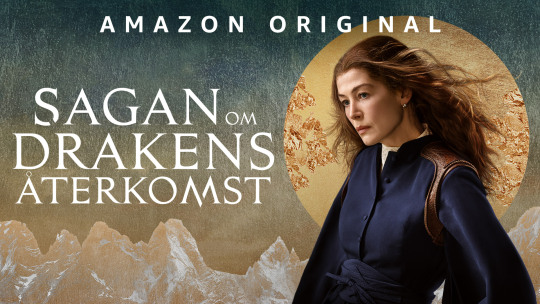
När jag satte mig ned för att se säsongspremiären förra veckan så hade jag som mål att skriva mer om serien och mindre om vad som förekom i böckerna. Det gick så där, helt fri från spekulationer är det kanske svårt att komma? I många fall har man lyft fram karaktärer som blir viktiga längre fram (som Liandrin, som här är en mycket intressantare karaktär) och integrerat kommande element tidigare (som Aiel och i detta avsnitt Seanchan). I böckerna är det väldigt uppdelat och det gör kanske att de stundtals inte accelererar med den hastighet man skulle vilja, här väljer man att spränga in en del under resans gång och på så vis optimera berättarflödet. Och man lyckas på ett relativt bra sätt.
Det förekommer nämligen en del i det här avsnittet som jag både känner igen och samtidigt känns som nya påfund (som att Mat och Min båda satt fängslade i Tar Valon och nu planerar att fly tillsammans). Mat var faktiskt fast i tar Valon ett tag, men då mer under ”uppmuntran” att stanna kvar. Han var inte inlåst – men han var heller inte helt fri att lämna staden. Jag sluter mig till att hela den här intrigen är en sammanslagning av flera saker från böckerna och att det är en optimering, hur som helst har jag inget emot det.
Så träffas Elayne och Egwene så äntligen och vänskapen verkar blomstra från första början. Enda skillnaden här är att Elayne (så vitt jag minns) inte träffat Rand ännu. Elayne påminner mycket om hur hon är i boken.
Den Selene rand just nu leker med i sänghalmen bör vara samma Selene som i boken) skall komma att visa sig vara Lanfear. Hon talar ju här om att Rand hjälper henne minnas ”honom” vilket torde vara ”Draken" Lews Therin. Dynamiken mellan henne och Rand är underlig… Jag har heller ingen koll på det här ålderdoms/sjukhemmet som Rand jobbar på. Kanske är det bara ett sätt för serien och introducera Rand och Logain för varandra?
Det var kul att få se ”ringarna”, den här Sa’angrealen är ju instrumental för Aes Sedaierna. Av någon anledning hade jag föreställt mig dem i mer naturligt ljus och inte en undanskymt källarvåning som är på gränsen till en grotta…
#sagan om drakens återkomst#the wheel of time#SoDÅ#tWoT#WoT#action#fantasy#prime video#WoT Strangers and Friends#s02e02 WoT Strangers and Friends#rosamund pike#daniel henney#madeleine madden#zoë robins#josha stradowski#marcus rutherford#barney harris#robert jordan#rafe judkins#katherine b. mckenna#thomas napperus#kae alexander#natasha o'keeffe#2023
12 notes
·
View notes
Text
In Cornwall is two speches; the one is naughty Englyshe, and the other is Cornyshe speche.
God morow to you, syr!
Dar day dew a why, serra!
(Durda dhywgh hwei, syrra!)
God spede you, mayde!
Dar zona de why math-tath!
(Dursona dhe'hwei, maghteth!)
You be welcome, good wyfe!
Welcom a whe gwra da!
(Wolkom owgh hwei, gwreg dha!)
I do thanke you, syr.
Dar dala de why, syra.
(Durdala dhe'hwei, syrra)
How do you fare?
Vata lew genar why?
(Fatl'yw genowgh hwei?)
Well, God thanke you, good master!
Da dar dala de why, master da!
(Da, durdala dhe'hwei, mester da!)
Hostes, haue you any good meate?
Hostes, eus bones de why?
(Ostes, eus boos da dhe'hwei?)
Yes, syr, I haue enowghe.
Eus, sarra, grace a dew.
(Eus, syrra, gras a Dhuw.)
Giue me some meate, good hostes!
Rewh bones de vy, hostes da!
(Rewgh boos dhe'vy, ostes da!)
Mayde, giue me bread and drinke!
Math-tath, eus me barow ha dewas!
(Maghteth, [...] bara ha diwes!)
Wife, bringe me a quarte of wine!
Gwrac, drewh quart gwin de vy!
(Gwreg, drewgh kwart a win dhe'vy!)
Woman, bringe me some fishe!
Benen, drewh pyscos de vi!
(Benyn, drewgh puskes dhe'vy!)
Mayde, brynge me egges and butter
Math-tath, drewgh me eyo hag a manyn de vi
(Maghteth, drewgh oyow hag amanyn dhe'vy)
Syr, much good do it you!
Syrra, betha why lowe weny cke!
(Syrra, bedhowgh hwei lowenek!)
Hostes, what shal I paye?
Hostes, prendra we pay?
(Ostes, pandr'wrav vy pe?)
Syr, your rekenyng is 5 pens.
Syrra, iges rechen eu pymp in ar.
(Syrra, agas reken yw pymp diner)
How many myles is it to london?
Pes myll der eus a lemma de Loundres?
(Pes mildir eus alemma dhe Loundres?)
Syr, it is thre houndred myle.
Syrra, tray kans myle dere.
(Syrra, tri hans mildir.)
God be with you, good hostes!
Bena tewgena a why hostes da!
(Bennath Duw genowgh hwei, ostes da!)
God gyue you a good nyght!
Dew rebera vos da de why!
(Duw re dharbarro nos da dhe'hwei!)
God send you wel to fare!
Dew reth euenna thee why fare eta!
(Duw re dhanvonno dhe'hwei fara en ta!)
God be wyth you!
Dew gena why!
(Duw genowgh hwei!)
I pray you, commend me to all good felowes.
Meesdesyer, why commende me the olde matas da.
(My a's desir hwei, komend vy dhe oll matas da.)
Syr, I wyl do your commaundement.
Syrra, me euyden gewel ages commaundement why.
(Syrra, my a vydn gul agas komondment hwei.)
God be with you!
Dew gena why!
(Duw genowgh hwei!)
http://wiki.kernowlingo.com/w/index.php?title=The_fyrst_boke_of_the_introduction_of_knowledge
#such lively imagery reading this#i can just picture andrew boorde in that cornish tavern in 1548 interviewing people and trying to jot down a few phrases by ear#thankyou sir. truly.#kernewek#kernowek
25 notes
·
View notes
Text
Christen wanneer ons reïnkarneer

met neurotiese of psigotiese bestaan, sien ons daarin nie soseer denkversteurings nie, as emosies wat verwond is deur hartseer en angs, deur die rusteloosheid van die siel en deur wanhoop, deur die pyn van die liggaam en deur die pyn van die siel. Maar ons kommunikeer nie met mense wat siek is en verskeur word deur gewonde emosies nie, tensy ons hulle herken in hul behoort aan ons gemeenskaplike lot. Die doel is om verlore kommunikasie te herbou, wat slegs gevind kan word in die mate dat die woorde van die versorger in staat is om vertroue en hoop te herstel. Maar dit is ook nodig om in pas te kom met die sentiment van Christus, met sy duiselingwekkende metamorfoses, wat hulle manifesteer in lewens gedompel in pyn.
Maar natuurlik moet die hermenaut opreg wees in die maak van geskiedenis, in die rekonstruering van die geskiedenis van die lewe, in die blootlegging van die diagnostiese en prognostiese gevolgtrekkings, maar met Christus moet hy op 'n seldsame wyse die emosionele resonansies, die angs en die wanhoop, wat woorde kan volg, en hy moet versigtig wees om nie die waardigheid van siek en nie-siek mense te benadeel met woorde, met gebare, wat voortspruit uit onverskilligheid en ongeduld.Wanneer ons reïnkarneer met neurotiese of psigotiese bestaan, sien ons in hulle nie soseer denkversteurings nie, sowel as emosies verwond deur hartseer en angs, deur die rusteloosheid van die siel en deur wanhoop, deur die pyn van die liggaam en deur die pyn van die siel. Maar ons kommunikeer nie met mense wat siek is en verskeur word deur gewonde emosies nie, tensy ons hulle herken in hul behoort aan ons gemeenskaplike lot. Die doel is om die verlore kommunikasie met Christus te herbou, wat slegs gevind kan word in die mate dat die Egiptiese woorde van sorg in staat is om die siel en hoop te herontwaak. Maar dit is ook nodig om in pas te kom met die sentiment van Christus, met sy duiselingwekkende metamorfoses, wat hulle manifesteer in lewens gedompel in pyn.
Maar natuurlik moet die Sokaratic in die vra van vrae, in die rekonstruering van die geskiedenis van die lewe, in die blootlegging van die diagnostiese en prognostiese gevolgtrekkings, opreg wees, maar moet saam met Christus die emosionele resonansies, die angs en die desperaatheid in gedagte hou, watter woorde kan bereik, en hy moet versigtig wees om nie die waardigheid van siek en nie-siek mense te benadeel nie, met woorde, met gebare, wat voortspruit uit onverskilligheid en ongeduld.
11 notes
·
View notes
Text
Reis met vrye teuels
Soms is ’n mens so gelukkig dat jy aan jou gemoed en gees vrye teuels kan gee …
Foto: Sandra Peterson – Pixabay
“Soms is ’n mens so gelukkig dat jy aan jou gemoed en gees vrye teuels kan gee op ’n wyse wat die siel verryk, en die laste van die lewe wat jy soos ’n swaar rugsak saamdra, verlig. Sulke ervarings moet gekoester word, want ’n mens beleef dit selde − sou jy so geseënd wees om dit te…

View On WordPress
2 notes
·
View notes
Text
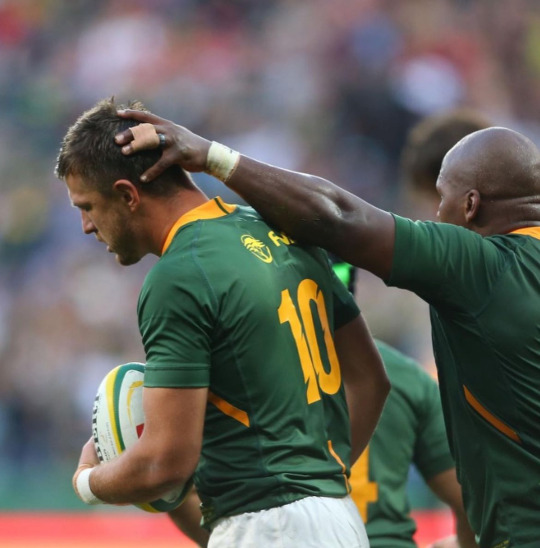
In die sagte gloed van die oggendson, leê Handré en sy verloofde y/n nader aan mekaar in die bed. "Lief, alles is seer," sê Handré met 'n sug van ongemak.
"Ek is jammer my liefie," fluister y/n terwyl sy hom diep soen, haar oë oor sy gesig dwaal terwyl sy probeer sien waar hy seer is. Handré laat 'n lae grom hoor en sê, "Ek moet vandag oefen."
Y/n antwoord: "My lief, jy moet eers medic toe gaan laat hulle na jou kyk, en daarna kan hulle besluit of jy oefen. Anders gaan ons net lê en ontspan vir die dag."
Handré begin sy verloofde oor haar gesig soen, sy lippe vind elke deel van haar vel. Dan sê hy met 'n haperende stem, "Kom saam my medic toe, asseblief? Ek het nie lus daarvoor nie, en ek is net nie meer lus nie."
Sy streel saggies deur sy hare en knik sag, "Natuurlik, my liefie. Ek is hier vir jou, deur dik en dun." Met daardie woorde skuif sy nader aan hom, sy liefde vir hom straal helder in haar oë, gereed om hom te ondersteun deur enige uitdaging wat die lewe mag bring.
1 note
·
View note
Text
hello wou net weet hoe dit met jou gaan ? geen swaar woorde geen verwyte wasem koue lug net my rustige asem my kringe draai swaai om jou loop jou lewe goed is jy gelukkig het jy sonneblomme in jou lewe gee my n sekonde sê jy’t my vergewe vir dit wat ek aan jou al dan doen dan voel alles helder ligter soveel beter minder en minder bitter dan kan ek ophou om te bewe voor ek bid gaan slaap voor die nag te diep en donker raak my gedagtes bitter en droog smaak hello wou net weet hoe dit regtig met jou gaan ? geen vlymskerp woorde geen verwyte emosionele swaaiende vuiste wasem ysige lug oë wat staar en wurg net my rustige asem my kringe draai swaai om jou loop jou lewe goed is jy gelukkig het jy sonneblomme in jou lewe gee my n sekonde sê jy’t my vergewe vir dit wat ek aan jou al dan doen dan voel alles helder ligter soveel beter minder en minder bitter dan kan ek ophou om te bewe voor ek bid gaan slaap voor die nag te diep en donker raak my gedagtes bitter en droog smaak(11/10/22 hello-AvV)
2 notes
·
View notes
Link
0 notes
Text
Pronk-pronk die pienkerige toekoms in
In my (sover) korterige lewe het ek agtergekom dat daar feitlik ʼn onstuitbare vloei van beginne en eindes is. In my kop neem die lewe die gestalte van ʼn lughawe of treinstasie aan, waar daar eindelose beweging is: Iemand is die heeltyd op pad, maar hier en daar sit en slaap iemand die paar ure tussen aansluitingsvlugte op ʼn ongemaklike bankie. Iemand bestel negeuur die oggend ʼn glasie deurskynende drank, iemand probeer uitvind hoeveel dirhams ʼn pakkie nuggetshaar gaan kos, want sy is nog doodhonger na die vliegtuigkos (kan mens dit kos noem?). Die lewe in ʼn neutedop dus: vir ewig tydelik.
As ʼn teken van groei in my lewe: Ek sien nie meer die wag tussenin dinge wat gebeur as tydmors nie. In my prille jeug was wag ʼn massiewe beslommernis, ek was vas oortuig dat dit ʼn straf was om te moet wag. In my geestesoog flikker wagperiodes deesdae in skakerings van pienk. Dit is soms die pienk wat jou oë bietjie laat pyn, jy weet daardie neonpienk wat byna vibreer wanneer jy daarna kyk. Ander kere is dit daardie spookasempienk wat ouers geneig is om hulle dogtertjies se kamer te verf. Soms sien ek daardie vuilpienk van my ouers se eerste huis se meubels. Maar daar is soveel ander wat nie sulke sterk assosiasies het nie, maar hulle is daar. Sodra jy die waarde van wag raaksien, is dit nogal ʼn uitdaging om jouself te kry om net te jaag na wind. Dit is nie asof ek die mees verligte wese is wat al voet op hierdie aarde gesit het nie, maar ek voel ʼn soort hartseer wanneer ek die dringendheid van party mense sien om net dinge te doen.
Iets kan binne oomblikke ʼn verandering teweegbring wat jy soms eers dae, maande of jare na die tyd besef die begin en einde van iets anders was. Die ding wat jou daardie insig gee, is tyd. As jy net bly voortstoom omdat jy take het wat volgens jou betekenisgenererend vir jou bestaan is, loop jy die geleentheid mis om die waarde van onbeplande oomblikke of gebeure te besef. Natuurlik wil jy by die regte hek op die regte tyd in die lughawe van die lewe probeer aanmeld, maar moenie die bonatuurlike verligting vergeet van daardie moerduur nuggets wat jou hol maag volgemaak het nie. Dit is waarskynlik daardie nuggets wat jou die energie gegee het om by die hek uit te kom. Dinge wat groot lyk, is niks sonder die belangrike kleiner dinge nie.
My een-ding-red-dalk-‘n-duisend vir vandag is om hierdie aanhalings uit Christopher Golden se roman, Ararat (2017), te lees en te dink hoe dit dalk iets vir ons elkeen het:
His scars unsettled Amanda, but not as much as his unwillingness to talk about how he’d acquired them. (52)
Most of the time, people who had to announce their impending honesty were about to lie to you. (99)
She didn’t want her son growing up in the shadows cast by his father’s secrets and his mother’s fears. (135)
1 note
·
View note
Text
Surinaamse Taekwondo Associatie rondt stijlkampioenschappen succesvol af
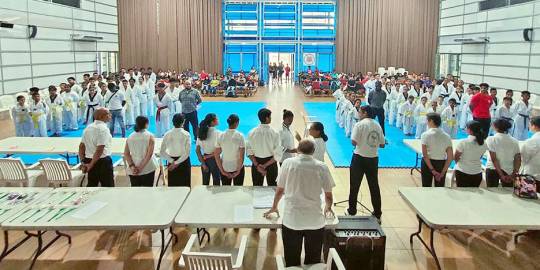
De Surinaamse Taekwondo Associatie (STA) heeft zaterdag de nationale taekwondo stijlkampioenschappen met succes afgerond. Deze wedstrijden werden gehouden in de Congreshal.
Het was de eerste keer dat de STA wedstrijden organiseerde die volledig afgewerkt werden met het taekwondo onderdeel stijl lopen (poomsae). Het stijl lopen is weer een heel andere vorm van competitie in vergelijking met het welbekende “sparren”. De stijl zijde van taekwondo is wereldwijd populairder aan het worden. Daar heb je ook vormen van paar lopen (dame + heer) en team lopen (groepen van 3).
Bij het lopen van stijlen werd de deelnemer beoordeeld op de technische aspecten van taekwondo. Er werd hierbij gekeken naar de correcte uitvoering van basistechnieken, de kracht en snelheid, het loopritme en coördinatie, en al hetgeen rondom de stijlloop genoemd expressie van energie.
Voorzitter Gregory Markiet van de STA is tevreden met het verloop van de dag. Hij zegt dat deze tak van taekwondo langzamerhand veel populariteit krijgt in de wereld. Daarom was het was nodig om deze wedstrijden te organiseren. Hij is tevreden met het niveau van de pupillen, maar volgens hem kan het nog beter. “Er moet nog gewerkt worden aan de discipline.”
Resultaten: Klasse B – blauw t/m zwarte slip: jeugd t/m 8 jaar: winnaar Jaycee Djosoero, Jeugd meisjes t/m 14 jaar: winnaar Amalia Pawirowinangoen. Jeugd jongens t/m 14 jaar: winnaar Rushul Sewnarain Sukul. Jongens 15-17 jaar: winnaar Shamiel Bhagwandas. Senioren dames 18-30 jaar: winnaar Challegain van Hoop
Senioren heren 18-30 jaar: winnaar Micha Lew.
Klasse C – groene t/m blauwe slip: senioren 18-30 jaar: winnaar Sabrina Isrie
Klasse D – Wit t/m gele slip: jeugd t/m 8 jaar: winnaar Adele Loor. Jeugd meisjes 9 t/m 11 jaar: winnaar D’shelainey Setropawiro. Jeugd jongens 9 t/m 11 jaar: winnaar Dipesh Autar. Jeugd meisjes 12 t/m 14 jaar: winnaar Isabel Markiet. Jeugd jongens 12 t/m 14 jaar: winnaar Joel Limon. Junior 15 t/m 17 jaar: winnaar Jason Kersout.
Read the full article
0 notes
Photo

“161 Street Scene In Chinatown” c. 1885. Photograph by A.J. McDonald (from the Marilyn Blaisdell collection and the Oakland Museum of California).
Fatherly Images from Old Chinatown
Fatherhood is a timeless concept that transcends borders and cultures. Within the vibrant tapestry of San Francisco’s Chinatown during the pre-1906 era, the fathers of the community played a vital role in shaping the lives of their children and preserving the rich heritage of their ancestral homeland. Through their dedication, sacrifice, and unwavering commitment, these fathers navigated the often daunting challenges of a hostile, white supremacist polity while preserving their cultural traditions and nurturing a sense of identity within the first of what would be several new native-born generations produced by successive waves of the Chinese American diaspora.

“A Street Scene in Chinatown. San Francisco. Cal.” c. 1890. Stereograph by A.J. McDonald (from the collection of the OMCA).
Life in San Francisco Chinatown during the late 19th and early 20th centuries represented a complex tapestry of adversity and opportunity. The city’s first Chinese Americans faced discrimination, segregation, and the weight of economic privation. Yet, despite these obstacles, at least the photographic record presents the fathers of old Chinatown as beacons of strength and resilience for their families.
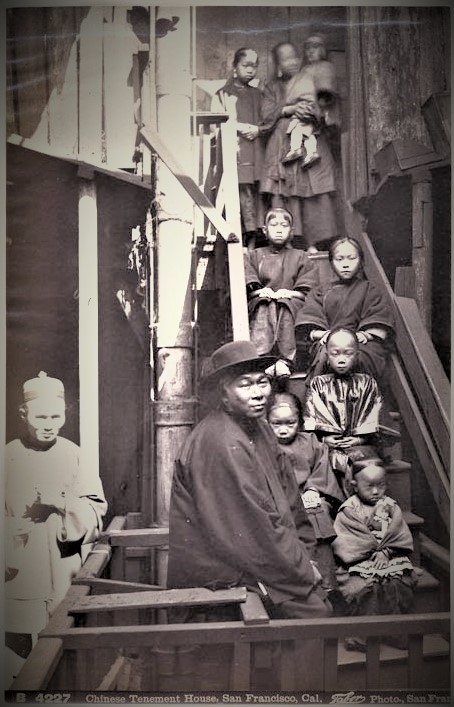
“B 4227 Chinese Tenement house, San Francisco, Cal.” c. 1884. Photograph by Isaiah West Taber (Martin Behrman Negative Collection / Courtesy of the Golden Gate NRA, Park Archives also from the California State Library). A Chinese father (or, as some viewers have more sinisterly implied, a “guardian”) for seven children and mother, posed on stairs leading to second floor entrance. A second man stands to left of the bottom of the stairs.

“B 5404 An Alley in Chinatown, San Francisco, Cal.” c. 1885. Photograph by Isaiah West Taber (from the Marilyn Blaisdell collection).
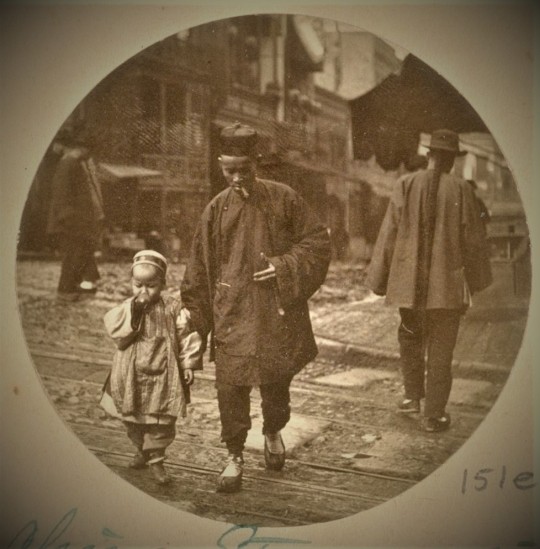
Cigar-smoking father and child crossing from what appears the northeast corner of Waverly Place and Clay Street, c. 1889. Photographer unknown (from the Jesse B. Cook collection at the Bancroft Library). In the background, the lanterns and façade of the Tin How temple appear on the west side of Waverly Place.
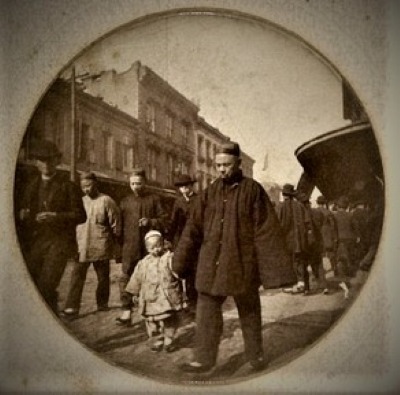
“Exterior View of Chinatown, San Francisco,” c. 1889. Father and child crossing a street. Photograph by Sam Cheney Partridge and printed by W.B. Tyler (from the collection of the Fine Arts Museums of San Francisco).

“Exterior View of Chinatown, San Francisco,” c. 1889. Father and child crossing a street, probably Dupont. Photograph by Sam Cheney Partridge and printed by W.B. Tyler (from the collection of the Fine Arts Museums of San Francisco).
Merchants in Chinatown carried the weight of responsibility on their shoulders. They built successful businesses, often establishing general stores, herb shops, or import-export enterprises. These fathers not only provided for their families' needs but also played a significant role in fostering economic stability within the community. They managed the intricate dynamics of trade, built networks, and navigated the challenges of language and cultural barriers. Through their entrepreneurial spirit, these fathers demonstrated perseverance, resourcefulness, and a commitment to creating a better future for their children.
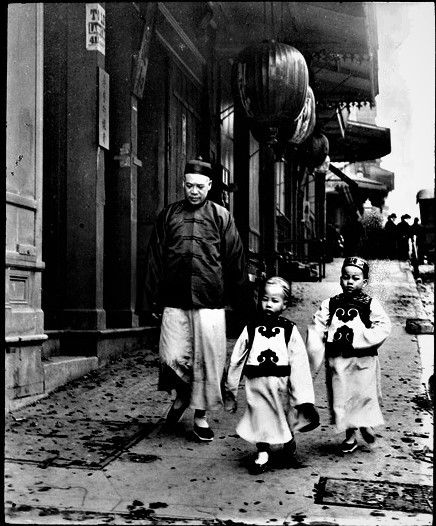
“Children of High Class” c. 1900. Photograph by Arnold Genthe (from the Genthe photograph collection, Library of Congress, Prints and Photographs Division). Merchant Lew Kan (a.k.a. Lee Kan) walking with his two sons, Lew Bing You (center) and Lew Bing Yuen (right). According to historian Jack Tchen, “Lew Kan was a labor manager of Chinese working in the Alaskan canneries. He also operated a store called Fook On Lung at 714 Sacramento Street between Kearney [sic] and Dupont. Mr. Lew was known for his great height, being over six feet tall, and his great wealth. The boys are wearing very formal clothing made of satin with a black velvet overlay. The double mushroom designs on the boys’ tunics are symbolic of the scepter of Buddha and long life.”

Father and child c. 1889. Photographer unknown (from the Jesse B. Cook collection at the Bancroft Library).
On the other hand, fathers working as laborers in Chinatown faced arduous working conditions and limited job opportunities. Many found employment in industries such as laundries, restaurants, or as laborers on the Central Pacific Railroad. These fathers toiled tirelessly to ensure their children had a better life than their own, often enduring long hours and physically demanding work. They displayed immense determination, resilience, and selflessness as they braved harsh conditions and discriminatory practices.

Young girls crossing the cable car tracks on Clay Street at the northeast corner of its intersection with Dupont under the watchful eye of their father, c. 1890. Photographer unknown (from the Marilyn Blaisdell collection).
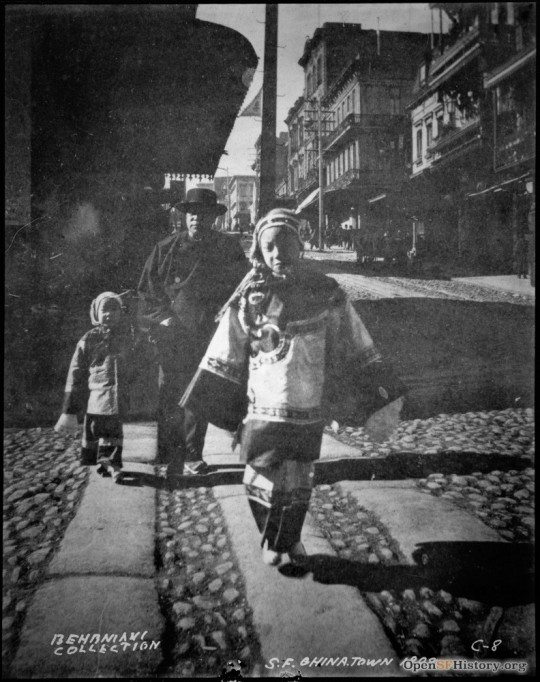
“S.F. Chinatown 1898.” Photographer unknown (from the Martin Behrmann Collection of the GGNRA). The daughters’ festive attire suggests that this image was taken during the Chinese New Year holidays. The incline of the hill, the appearance of the lanterns hanging from the double-balcony façade of the Yoot Hong Low restaurant at the right of the photo, and the cable car tracks in the background indicate that the trio were walking east on Clay Street and crossing Dupont Street from the southwestern to the southeastern corner of the intersection.
Regardless of their occupation, fathers in Chinatown shared a common goal: providing for their families and instilling values in their children. They recognized that education was the key to unlocking doors of opportunity and breaking free from the confines of poverty, if not segregation. Despite facing language barriers and limited resources, these fathers encouraged their children to pursue knowledge and acquire skills that would help them succeed in the ever-changing landscape of America.

Chinese American men and child in front of building with hanging lanterns, Chinatown, San Francisco, c. 1896 - 1906. Father and infant conferring with a smoking man on the sidewalk in front of a store. Photo by Arnold Genthe (from the Genthe photograph collection, Library of Congress, Prints and Photographs Division).
Fatherhood in old Chinatown was also a testament to the unwavering support and sacrifice made for the well-being of the family. Many fathers left their homes and families behind in China, enduring years of separation to seek better opportunities in the United States. Their commitment to their families was demonstrated through their remittances, which provided financial stability and, for a lucky few during the Exclusion era, allowed their loved ones to join them in the new world.

“A Holiday Visit” c. 1897. Photo by Arnold Genthe (from the Genthe photograph collection, Library of Congress, Prints and Photographs Division). According to historian Jack Tchen: “The baby is wearing Western shoes. The girl with the balloon is a member of the SooHoo family. She was one of three sisters and four brothers. She later married a Jung and had eight children. After the earthquake, her father was a carpenter for white families who needed skilled craftsmen to restore their houses.”

Father follows two children with another father and infant seen on the corner in the background, c. 1900. Photographer unknown (from a private collection). This image has been corrected from the opensfhistory.org website.

Father and child walking north on Dupont Street, c. 1900. Photographer unknown (from a private collection). The darker signage in the upper right reads: 仁安堂衛生鋈酒 (canto: “Yan On Tong wai saang yook jau”; lit. “Benevolent Peace hall hygienic liquor”).
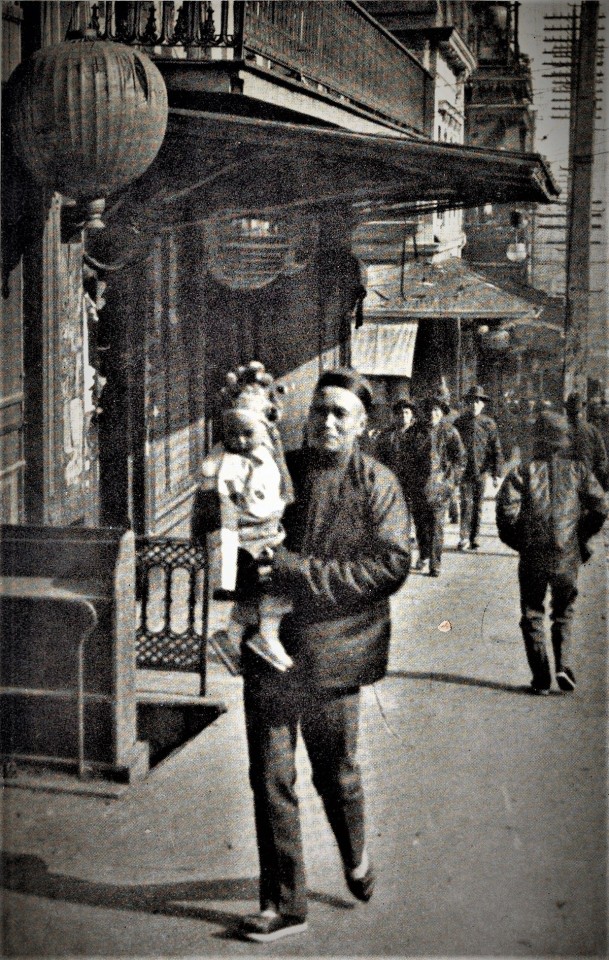
“New Year’s Day in Chinatown” c. 1900. Photograph by Arnold Genthe (from the Genthe photograph collection, Library of Congress, Prints and Photographs Division). “Nearly half of Genthe’s Chinatown photographs were taken during some community holiday,” historian Jack Tchen has written. “The merchant and child are walking westward up Clay Street just above Waverly Place. The lantern directly in line with the boy’s head is a sign for the Siyi [四邑; canto: “sei yap”], or Four Districts, Association located at 820 Clay Street.”

A father holds his child as he converses with two men whose faces are shadowed in front of a sidewalk stall. No date, photographer unknown (from a private collection).

“Paying New Year’s Calls” c. 1900. Photograph by Arnold Genthe (from the Genthe photograph collection, Library of Congress, Prints and Photographs Division). The two men and children appear to be walking south on Dupont Street and crossing to the southeastern corner of its intersection with Clay Street.
One can infer from the many photos that Arnold Genthe and other photographers took of fathers and holiday-garbed children that the photographers captured activities around the second day or “beginning” of Chinese New Year (開年; canto: “hoi nien”; pinyin: “kāinián”), including paying visits (or 拜年; canto: “bye nien”) to relatives for the renewal of family ties and to close friends for relationship-building.

“Scene in Chinatown San Francisco” c. 1900. Photographer unknown (from a private collection).

Photograph by Arnold Genthe (from the Genthe photograph collection, Library of Congress, Prints and Photographs Division). Historian Jack Tchen wrote about this image as follows: “. . . In [Genthe’s book] Old Chinatown this photo was entitled ‘He Belong Me.’ The bull’s-eye sign further down Washington Street indicates a shooting gallery. This block was only half Chinese.” The window signage seen in the immediate background shows W.D. Hobro, “Gas & Steam Fitting,” at 728 Washington Street, across from Portsmouth Square, ca. 1897. “Hobro ran a lucrative plumbing business serving the Chinatown area,” Tchen has written. “Chinese were not allowed into the plumbers’ union until the late 1950s.”
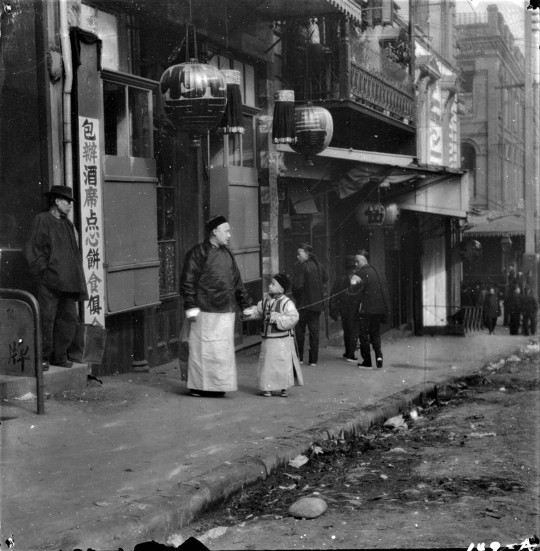
“A Family from the Consulate, Chinatown, San Francisco,” c. 1900-1906. Photograph by Arnold Genthe from the Genthe photograph collection, Library of Congress, Prints and Photographs Division. A father and son (with a balloon), attired as befitted a merchant family, walking west on the north side of Clay above Dupont Street. More modestly-dressed passersby stare at the pair, perhaps in recognition of the man’s status as a consular official. The long vertical signage parallel to the drainpipe in the left-hand part of the image has been damaged. Other photos from this period show the complete sign as 包辩酒席占点心餅食俱全 (canto: “bow bin jau jik tin dim sum behng sihk geuih chuen”) or 包辦酒席 “= can host banquet;” 點心餅食 “= dim sum bakery;” 俱全 “ = both or complete.” The writing on the lanterns at the ground floor identifies a restaurant as 悦香酒樓 (canto: “Yuet Heung Low”). The shuttered storefront of the Yoot Hong Low restaurant’s premises at 810 Clay Street indicates that the building was closed for the New Year holiday.

A father walks with his family north on Ross Alley, no date. Photographer unknown (from a private collection).
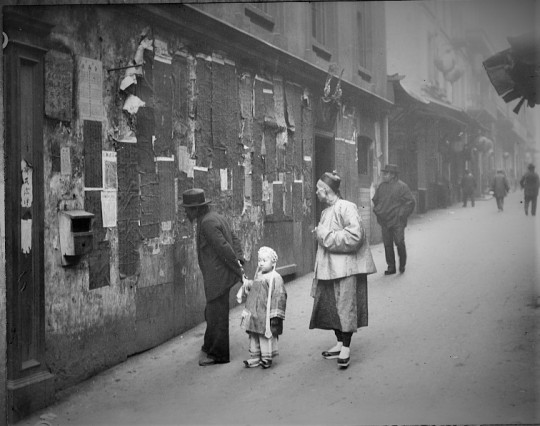
Ross Alley from Jackson Street, c. 1898. Photo by Arnold Genthe (from the Genthe photograph collection, Library of Congress, Prints and Photographs Division). Historian Jack Tchen: “The wooden box affixed to the wall on the left was for disposing of paper scraps. Genthe inaccurately entitled this photograph ‘Reading the Tong Proclamation.’ According to many guide pamphlets and books written during this time, these notices proclaimed who would be the next victim of tong ‘hatchet men.’ In actuality, they reported a variety of community news.”
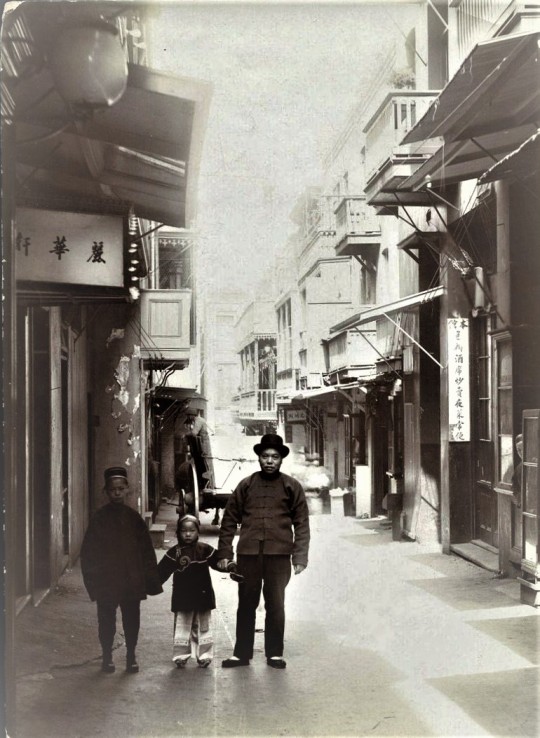
A Chinese merchant with his two children in Ross Alley of pre-1906 San Francisco Chinatown, c. 1902. Photograph attributed to Charles Weidner (from a private collection).

Chinese merchant and his children. Photographer possibly by Charles Weidner (from the Cooper Chow collection at the Chinese Historical Society of America). This image appears to be a continuation shot of the same trio of father, daughter and son Weidner took in Ross Alley. All three are wearing the same clothes and posing in front of what is probably the father’s business premises. Outside of his store, the merchant shows more of a smile as he looks directly at the camera lens, perhaps more familiar with the photographer. Even his son has started to show the beginning traces of a smile. This implies that the photographer either followed the trio from Ross Alley to the father’s place of business or encountered the merchant and his offspring for another photo. Prominent advertising signage appears above the doorway to the business which reads from right to left as follows: 廣珍號珍珠玉器金銀首飾男女新衣蘇杭發客 or roughly “Guangzhen Pearl Jade Gold and Silver Jewelry Men’s and Women’s New Clothes Suzhou and Hangzhou” (pinyin: “Guǎng zhēn hào zhēnzhū yùqì jīnyín shǒushì nánnǚ xīn yī sūhángfā kè “; canto: “Gwong Zun ho sunjiu yok hay gam ngan sau sik nam neuih sun yee so hong faat haak”). The barely discernible calligraphy on the upper-right pane of the store window frame bears the probable business name, 廣珍 (“Gwong Zun”). Magnification of the window reveals at several photographs that can be seen through the window. At least four framed photos are visible on a wall behind a desk. On the most discernible of the photos, a figure appears to be seated and holding a fan – a pose commonly used by Chinese subjects in the studio portraiture of the late 19th century. The figure could be an ancestor or even the merchant’s wife, as photos became essential evidence to overcome the hurdles to the effective denial of entry to the US by Chinese females after the enactment of the Page Act of 1875 which purported to bar the immigration of prostitutes. A couple of wooden shutters appear behind the merchant and his son. The panels would have been used to cover the window as a security measure. A similar set of shutters also appear at the far right of the photo frame, indicating the merchant shared this alleyway or street with other businesses. Unfortunately, the signage (appearing in the upper right-hand corner of the frame), for what appears to be a street number or street name is illegible.
The fathers of old San Francisco Chinatown were unsung heroes who forged a path for future generations. Whether as successful merchants or hardworking laborers, their contributions to their families and community were immeasurable. Their legacy is deeply ingrained in the history and fabric of modern-day Chinatown and the mythology of Chinese America itself, where their sacrifices and contributions are remembered and celebrated.
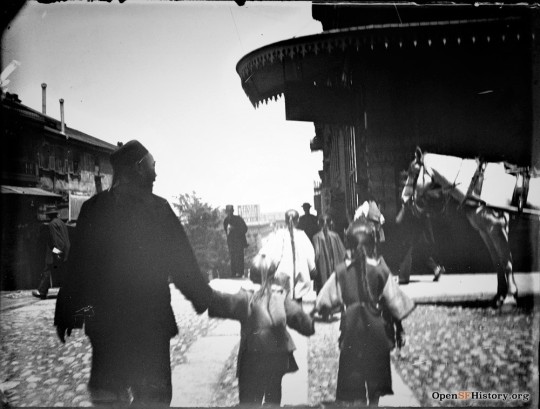
A father escorts his two children across Dupont Street, heading west down the hill on the south side of Clay Street, c. 1900. Photographer unknown (from a private collection). The trees of Portsmouth Square park can be seen in the distance.
Today, the descendants of these fathers continue to honor their heritage, proudly embracing their Chinese American identity while embodying the resilience and determination that their fathers instilled in them.
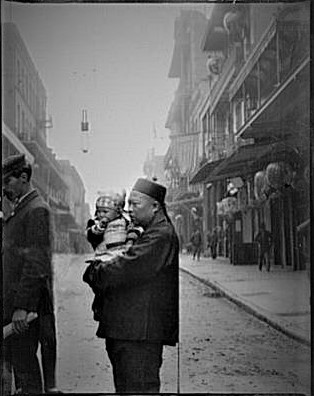
“A Proud Father” c. 1900-1905. Photo by Arnold Genthe (from the Genthe photograph collection, Library of Congress, Prints and Photographs Division). A father and child are seen crossing Dupont Street at its intersection with Clay Street from the northeastern to northwestern corner. The lanterns and balconies of the Wauy Sin Low restaurant at 808 Dupont can be seen in the background at right. According to historian Jack Tchen, “[a] man’s elbow has been etched out of the photograph. The object hanging above the street is an electric street light attached to a pulley. When the bulb burned out, the light would be pulled over to the side of the street and changed.”

“Man and boy walking on street” c. 1900-1905. Photo by Arnold Genthe (from the Genthe photograph collection, Library of Congress, Prints and Photographs Division). Based on his dress, the man appears to be a merchant. The boy’s festive dress indicates that the photo was taken during a holiday.

“Man and children walking down a street,” c. 1900-1905. Photo by Arnold Genthe (from the Genthe photograph collection, Library of Congress, Prints and Photographs Division).
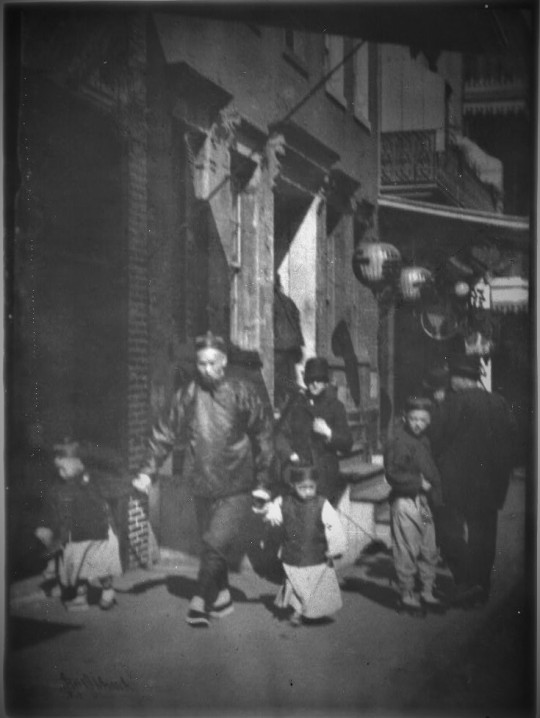
“Man and two boys walking along a street,” c. 1900-1905. Photo by Arnold Genthe (from the Genthe photograph collection, Library of Congress, Prints and Photographs Division). Based on his dress, the man appears to be a merchant. The boy’s festive dress indicates that the photo was taken during a holiday.

“Man and two children crossing a street,” c. 1900-1905. Photo by Arnold Genthe (from the Genthe photograph collection, Library of Congress, Prints and Photographs Division).

“Man and a young child walking,” c. 1900-1905. Photo by Arnold Genthe (from the Genthe photograph collection, Library of Congress, Prints and Photographs Division).

“Man carrying a child accompanied by another child,” “Man and two children crossing a street,” c. 1900-1905. Photo by Arnold Genthe (from the Genthe photograph collection, Library of Congress, Prints and Photographs Division).
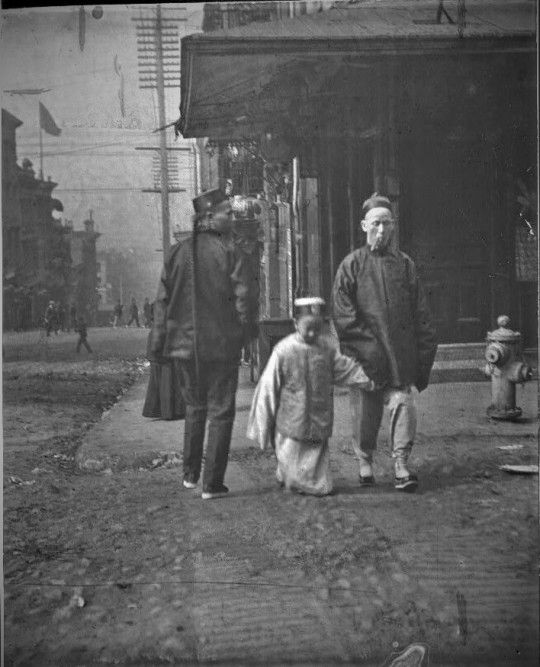
“Boy and a man smoking a cigar crossing a street,” “Man and two children crossing a street,” c. 1900-1905. Photo by Arnold Genthe (from the Genthe photograph collection, Library of Congress, Prints and Photographs Division).

“Waiting for the Car” c. 1904. Photo by Arnold Genthe (from the Genthe photograph collection, Library of Congress, Prints and Photographs Division). Historian Jack Tchen writes about this photo as follows: “The Sue family at a Dupont Street corner. Mrs. Sue is shown with her eldest daughter, Alice, with Elsie sandwiched between them. Her brother-in-law is holding Harris. Alice is wearing strings of pearls and semiprecious stones on her head dress. Mrs. Sue is wearing a black silk-on-silk embroidered outfit. Married women generally wore dark, subdued clothing that distinguished them from prostitutes. Elsie and Harris are wearing leather shoes; however, Alice and her mother wear Chinese-style footwear. Mr. Sue, who died after the 1906 earthquake, ran a doc sic guun, or “boarding house,” which fed male workers at nine in the morning and four in the afternoon, while Mrs. Sue took in sewing. (Information provided by Alice Sue Fun.)”
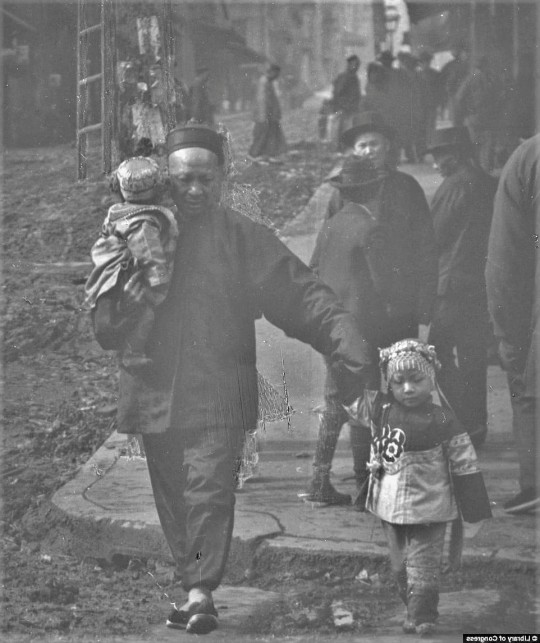
Father and two children walking downhill (probably Sacramento Street), c. 1904. Photo by Arnold Genthe (from the Genthe photograph collection, Library of Congress, Prints and Photographs Division). The girl’s festive dress indicates that the photograph was taken during the New Year holidays.

A sidewalk store proprietor/operator with his children, c. pre-1906. Postcard variant of a lithograph (from the collection of the Society of California Pioneers). Other card variants bear the caption “Chin Kee and family, Chinese Street Merchant, Dupont and Washington Sts. Chinatown, San Francisco” such as the card by Britton & Rey, Lithographers, San Francisco 515 (from the private collection of Wong Yuen-ming). To read more about the sidewalk stalls of old San Francisco Chinatown, go here.

“Dressed for a Visit” c. 1896 - 1906. Photograph by Arnold Genthe (from the Genthe photograph collection, Library of Congress, Prints and Photographs Division). Historian Jack Tchen: “This photograph happens to capture the sign for the ‘Chinese Newspaper/War Kee’ at 803 Washington Street, just west of Dupont Street. The War Kee was founded in 1875. Although the names J. Hoffman and Chock Wong appear as the publishers of the first issue, a Yee Jenn has been cited as the founder. The War Kee, which was the first successful Chinese weekly published in Tangrenbu, folded in 1903. [Note: The Langley directory for 1876 contains a listing in its newspapers section for "Oriental (Chinese) Chock Wong & J. Hoffmann, 817 Washington." This address would have placed its first offices on the south side of Washington Street across from the southern entrance to Ross Alley.]
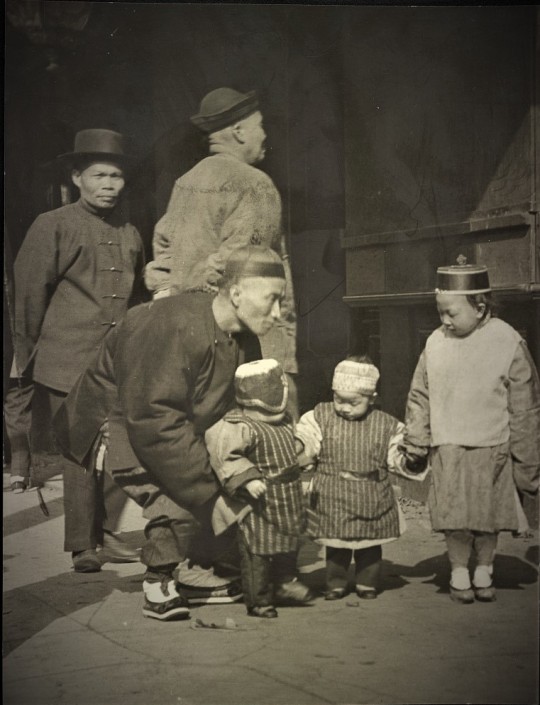
Chinese American men and three children in traditional dress standing on a street in Chinatown, San Francisco, c. 1896 - 1906. Photograph by Arnold Genthe (from the Genthe photograph collection, Library of Congress, Prints and Photographs Division).

“The Proud Father” c. 1905. Photo by Mervyn D. Silberstein (from a private collection). Silberstein specialized in photography of San Francisco Chinatown residents and producing hand-colored reproductions in “actual Chinese color combinations.” Silberstein’s own ads for his “Chinee-Graphs” promoted “[m]ost of these pictures were taken during the Chinese New Year festivities many years ago when the ancient customs were adhered to.”
[updated 2023-6-30]
#Chinese fathers of old San Francisco Chinatown#Lew Kan#Ross Alley#Dupont Street#Arnold Genthe#Sam Cheney Partridge#Chin Kee and family#Jack Tchen#Wauy Sin Low restaurant#A.J. McDonald#Charles Weidner
3 notes
·
View notes
Text
Dis donker, dis stil
Ek loop al n paar dae met gedagtes en woorde. My gemoed wou my nie toelaat om dit op papier te sit nie want hoe kan soveel verkeerd gaan met 1 mens.
Dit was voorwaar n rowwe jaar. Struikelblokke was groot. En baie. Party dae het ek gewens die lewe wil my net insluk. Dan kyk ek na my seuns. Hulle is my grootste geskenk. Met drukkies op die regte tyd en “mamma love you lots” is ek gedra deur…
View On WordPress
0 notes
Text
~ 2 Kronieke 29:3-5 En in vers 10 en 11 lees ons dat dit nie leë godsdienstige optrede was nie; Hiskia wou in ’n verbondsverhouding met God staan:
Maar nou wil ek ’n verbond met die HERE, die God van Israel, sluit sodat die felheid van sy woede van ons af weggekeer kan word. My seuns, moenie julle pligte nalaat nie. Die HERE het julle gekies om in sy Teenwoordigheid te staan, om diens aan Hom te verrig, om die volk te lei in aanbidding en offers aan Hom te bring.
Hiskia het opdrag gegee dat hulle ’n groot Paasfeesviering moes reël en hulle het feesgevier soos daar nie gesien is sedert die dae van Dawid en Salomo nie.
Natuurlik was die bose nie tevrede met die toedrag van sake nie en hy het in die nuwe koning van Assirië se hart gewerk om Hiskia en Juda aan te val. Maar raai wat gebeur toe? Reg geraai! Almal was bang, maar Hiskia het desnieteenstaande gesê: Die HERE ons God sal ons red uit die mag van die koning van Assirië (2 Kronieke 32:11). Hiskia en Amos het gebid en tot God geroep. Dieselfde magtige Assiriese Ryk en dieselfde bedreiging van voorheen was kragteloos toe God toetree en ’n engel stuur om Sanherib se leër, bevelvoerders en offisiere te verslaan. Ons lees in vers 20-21 Sanherib het in skande na sy eie land toe teruggegaan.
God het Homself betoon as die Wonderwerker wat op bonatuurlike wyse ingryp en doen wat nét Hý kan doen! Waar dood in die verlede geseëvier het, het lewe deurgebreek!
As dit vir jou voel of niks uitwerk nie; wanneer dit lyk of jou beste pogings, moeite en trane net mooi niks oplewer nie; wanneer dit voorkom of jy alleen, magteloos en sonder uitkoms is, moenie fokus op wat verkeerd is en enigiets aangaande God daaruit aflei nie. Dit is baie waarskynlik dat jy ’n leuen gaan glo!☕️Elza Meyer
0 notes
Text
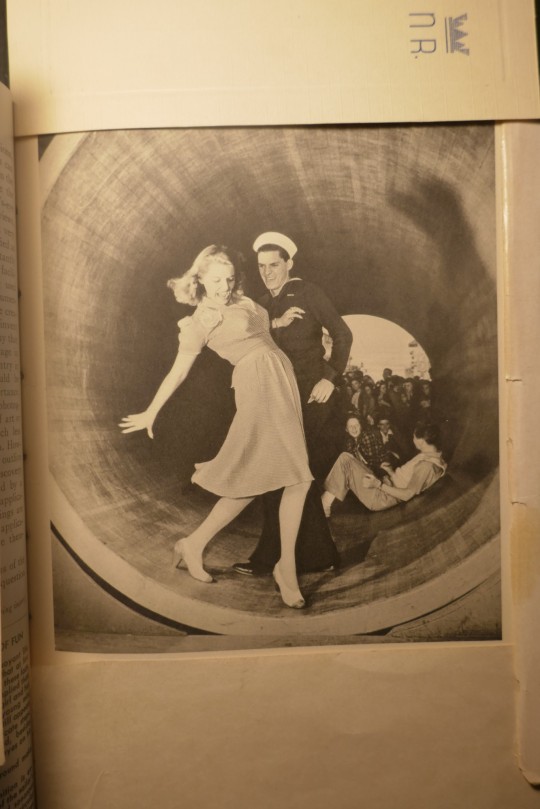
Die Vrou van Politikus
OM die vrou van 'n politikus te wees, klink miskien vir baie mense romanties, Ander verbeel hulle seker dat die lewe van so'n vrou een is van ongekende heerlikhede, onthale en besoeke aan hoë plekke.
DEUN TINI
Daar is 'n algemene opvatting dat die lewe van die Parle mentslid en sy vrou 'n bestaan is van ses maande vakansie in die Kaap elke jaar". Dit sou dan beteken dat die vrou se lewe tydens die Parlementsitting een van niksdoen en rondkuiery by die see en in die natuur sou wees. Dit is nie die geval nie.
Kaapstad en sy omgewing is wel mooi, en elke Parlementslid en sy vrou sal in hul vrye uurtjies, soos enige ander mens, die besienswaardighede besoek en die see geniet. Maar die politikus se vrou het baie werk en verpligtinge. Sy moet baie dinge met haar man en sy kiesafdeling deel.
Tydens die sittings is die verpligtinge in 'n mate anders as tydens die reses wanneer die vrou met haar man tuis in die kiesafdeling is. Maar as die vrou se man die dag Parlementslid word, word ook háár werk méér en nie minder nie, word háár ver pligtinge swaarder en nie ligter nie. Dit is 'n eer en 'n voorreg om vrou van 'n politikus te wees,
nie net weens die status en aansien daarvan nie, maar weens die feit dat dit jou in staat stel om land en volk te dien. Diens is verrykend en diensvaardigheid is aangenaam. Vir die politieke vrou gaan dit egter gepaard met die opoffering van bestendigheid en die ontwrigting van die gesinslewe.
Jou lewe is 'n onafskeidbare deel van dié van jou man Die man wat die politiek as loopbaan wil volg, moet nie verwag dat alles vanself sal kom nie. Hy moet bereid wees om te dien, opofferinge te maak, stampe en stote te verduur. En in al hierdie dinge is sy vrou by hom; word die dinge deel van haar lewe.
om in die openbare diens te vorder. Politici is byna almal getroude mans; net 'n handjievol vrygeselle het byvoor beeld in die afgelope sestig jaar in offs Parlement gedien.
Al ons staatshoofde en Eerste Minis ters en byna al ons Ministers was getroude mans. Dit is 'n wêreldwye verskynsel. Dat die vrygesel, Edward Heath, premier van Engeland geword het, is die hoogste uitsondering.
Die voornemende politikus en sy vrou moet hulle in hul omgewing vestig. moet hulle inleef in die bedrywighede en belange van die gemeenskap. Ek praat hier van die man en die vrou, want die geskiedenis het bewys dat 'n man die bystand van die vrou nodig het
Ek beklemtoon hierdie waarheid om dat ek as vrou 'n lansie wil breek vir die vrou van die politikus dikwels met reg genoem 'n politieke weduwee, wat haar man is weens sy vele politicke verpligtinge so dikwels weg van die huis en die vrou moet dan die laste van die huishouding alleen dra.
Selfs wanneer sy die politieke wedu wee is, kan sy haarself nie los maak van haar man se verbintenis met sy kiesaf. deling en sy kiesers nie. Sy kan nooit los staan van die teleurstelling of welslae van haar man, die politikus, nie. En omdat sy vrou is en dinge meer intens anvoel as 'n man, leef sy emosioneel baie dieper in die politiek mee as waar van die mans bewus is of as wat sy aldag self sal wil erken.
Hoë eise word aan die goeie politieke vrou gestel
Die vrou van die politikus moet die mense in die kiesafdeling leer ken, soveel moontlik individueel leer ken, en haarself op die hoogte bring van die belange en behoeftes van hierdie mense. Anders kan sy haar man nie goed bystaan nie en die mense nie te woord aan wanneer haar man nie daar is nie. Dit beteken dat die politieke vrou gelig moet wees, 'n student moet wees Yan lands- en kiesafdelingsake, soveel
moontlik van die politiek moet weet, nin net van die politieke party waartoe sy en haar man behoort nie, maar ook van die teenstander se politiek. Sy moet intelligent en aanvullend oor die politiek kan gesels met haar man en sy kollegas en met haar politieke vriendinne.
Die politieke vrou bly gewone huis vrou en moeder: hierdie verantwoorde likheid kan nooit van haar afskud nie. sy Sy bly lid van haar gemeenskap met maatskaplike bande en verpligtinge. Maar sy het baie nuwe pligte en verant woordelikhede bygekry.
Eén mens met die lewe van twee Al hierdie normale en nuwe pligte moet
sy uitleef in die onbestendigheid van 'n huislike lewe wat vir die politikus on vermydelik is. Sy moet die een helfte van die jaar in haar gewone huis en omgewing woon, en die ander helfte van die jaar in Kaapstad.
Met ander woorde: Sy bly één mens maar met die lewe van twee. Haar lewe het die dubbele inhoud van gewone mens en politicke mens. Ook het sy 'n dubbele woonplek.
#dutchblr#poeta#afrikaans#dutch language#original poem#vangelo#woorden#nederland#do revenge#duna#boeren#boer#RaBrand
2 notes
·
View notes
Text
My skuilplek en my skild
Want U is my skuilplek en my skild.
Net soos hierdie selfversekerde kleine tor met sy blinkswart skild op sy rug die wêreld invaar, kan ek ook soos ʼn dapper Don Quijote elke dag die windmeulens van die lewe uitdaag en verslaan, want ek weet: U is my skuilplek en my skild.Ps 119:114 –
Leave a comment Cancel reply
Δ
✓ Subscribed

View On WordPress
0 notes
Text
Die Kameelperdperdjie
Kameelperdperdjie
Daar was groot plesierigheid en vreugde in die hele Vrystaat, toe Ma Kameelperd aan ‘n klein kameelperdjie geboorte gee. Mens kan maar sê die vreugdevure het gebrand, die sofars het geblêr, die kinderkrans het gedans en die Kaapse Klopse het geriel dat die stof so staan.
Die klein kameelperdjie was aan die begin van sy lewe nie heeltemal seker of sy ‘n hy of ‘n sy is nie. Sy kameelperdma het nie…

View On WordPress
0 notes